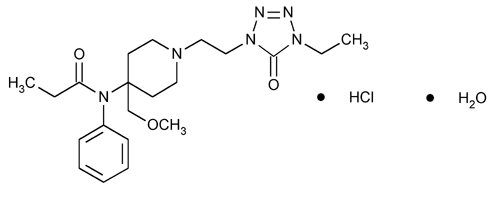Alfentanil Hydrochloride
Propanamide, N-[1-[2-(4-ethyl-4,5-dihydro-5-oxo-1H-tetrazol-1-yl)ethyl]-4-(methoxymethyl)-4-piperidinyl]-N-phenyl, monohydrochloride, monohydrate.
N-[1-[2-(4-Ethyl-5-oxo-2-tetrazolin-1-yl)-ethyl]-4-(methoxymethyl)-4-piperidyl]propionanilide monohydrochloride monohydrate
» Alfentanil Hydrochloride contains not less than 98.0 percent and not more than 102.0 percent of C21H32N6O3·HCl, calculated on the anhydrous basis.
Caution—Handle Alfentanil Hydrochloride with great care since it is a potent opioid analgesic. Great care should be taken to prevent inhaling particles of Alfentanil Hydrochloride and exposing the skin to it.
Packaging and storage—
Preserve in tight containers, and store at controlled room temperature.
Identification,
Infrared Absorption  197K
197K .
.
Water, Method I  921
921 :
not more than 4.0%.
:
not more than 4.0%.
Residue on ignition  281
281 :
not more than 0.1%.
:
not more than 0.1%.
Chromatographic purity—
Mobile phase—
Prepare a filtered and degassed mixture of 0.01 M tetrabutylammonium hydrogen sulfate and acetonitrile (86:14). Make adjustments if necessary (see System Suitability under Chromatography  621
621 ).
).
Standard solution—
Dissolve an accurately weighed quantity of USP Alfentanil Hydrochloride RS in Mobile phase, and dilute quantitatively, and stepwise if necessary, with Mobile phase to obtain a solution having a known concentration of about 0.54 mg per mL.
Test solution—
Transfer about 54 mg of Alfentanil Hydrochloride, accurately weighed, to a 100-mL volumetric flask, dilute with Mobile phase to volume, and mix.
Chromatographic system (see Chromatography  621
621 )—
The liquid chromatograph is equipped with a 235-nm detector and a 4.6-mm × 25-cm column that contains spherical 5-µm packing L1. The flow rate is about 2 mL per minute. Chromatograph the Standard solution, and record the peak responses as directed under Procedure: the column efficiency is not less than 5400 theoretical plates, the tailing factor is not more than 1.3, and the relative standard deviation for replicate injections is not more than 1.0%.
)—
The liquid chromatograph is equipped with a 235-nm detector and a 4.6-mm × 25-cm column that contains spherical 5-µm packing L1. The flow rate is about 2 mL per minute. Chromatograph the Standard solution, and record the peak responses as directed under Procedure: the column efficiency is not less than 5400 theoretical plates, the tailing factor is not more than 1.3, and the relative standard deviation for replicate injections is not more than 1.0%.
Procedure—
Inject a volume (about 25 µL) of the Test solution into the chromatograph, record the chromatogram, and measure the responses for all of the peaks. Calculate the percentage of each impurity in the portion of Alfentanil Hydrochloride taken by the formula:
100(ri / rs)
in which ri is the response of each impurity peak, and rs is the sum of all of the peaks: not more than 0.5% of any single impurity is found, and the sum of all impurities is not more than 1.0%.
Assay—
Dissolve about 350 mg of Alfentanil Hydrochloride, accurately weighed, in 30 mL of glacial acetic acid. Add 3 mL of mercuric acetate TS and 3 drops of p-naphtholbenzein TS, and titrate with 0.1 N perchloric acid VS to a green endpoint. Perform a blank determination, and make any necessary correction. Each mL of 0.1 N perchloric acid is equivalent to 45.298 mg of C21H32N6O3·HCl.
Auxiliary Information—
Please check for your question in the FAQs before contacting USP.
Chromatographic Column—
| Topic/Question | Contact | Expert Committee |
| Monograph | Clydewyn M. Anthony, Ph.D.
Scientist 1-301-816-8139 |
(MDCCA05) Monograph Development-Cough Cold and Analgesics |
| Reference Standards | Lili Wang, Technical Services Scientist 1-301-816-8129 RSTech@usp.org |
USP32–NF27 Page 1448
Pharmacopeial Forum: Volume No. 29(6) Page 1834
Chromatographic columns text is not derived from, and not part of, USP 32 or NF 27.
